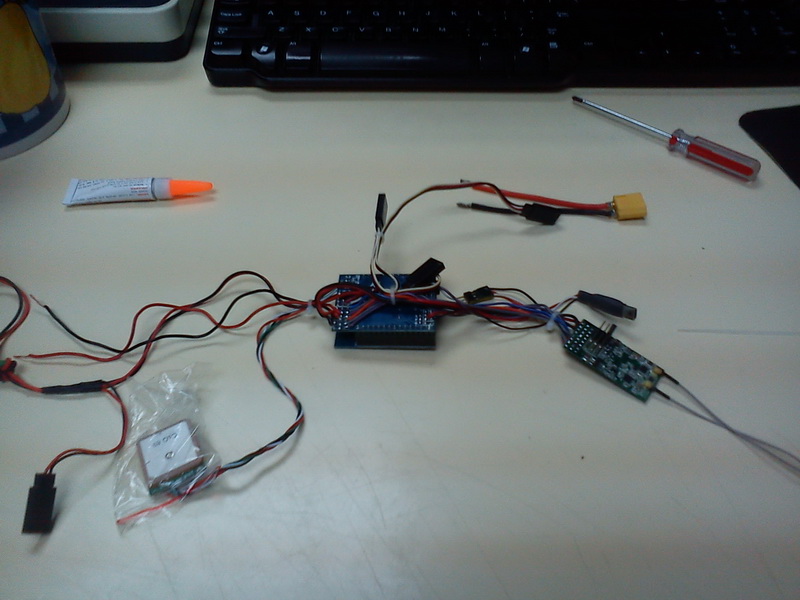FPV pilot, UAV and drone enthusiast like to stuff in their hardware into their favorite airframe especially when it was designed for LOS (Line Of Sight) recreation purposes. Manufacturer usually stated the airframe recommended "flight weight" as safe flying weight without affecting structural feature of the frame, aero dynamics, wing loading and its intended flight characteristic because the manufacturer knows and they engineer it. Just like buying a small 5 seater family sedan car, you don't put 7~8 people crammed inside or V12 engine into it else the frame stressed out and void warranty due to out of manufacturer recommended spec.
Some blunt minded hobby pilot also left their hardware dangling outside the airframe surfaces destroying the aerodynamics too causing the plane to be less efficient when pushing forward.
Ok lets get straight to the point what is the "optimal flying weight" for FPV/UAV flight? Follow the below formula because its proven:
**********************************************************************************************************
Formula:
[ Stock flying weight (declared by manufacturer) / 100 ] X (extra load range: 30% min ~35% max) + Stock flying weight) = Optimal flying weight for FPV
**********************************************************************************************************
Example of calculation #1:
HK/Art-tech P-51D Mustang 960mm stock flying weight: 500gram
Max tolerant load: 35%
- [ 500gram / 100 ] X 35% + 500gram
- [5] X 35 + 500
- 175 + 500
- =675
So the ideal total flying weight flying weight for full FPV setup on this plane is 675 gram
Comparison to my current setup on my FPV P-51D Mustang i'm close to tolerable at 715 gram (715 - 675 = 40 gram of extra bits..good enough)
Build reference: Click here to go to FPV P-51D Mustang build and medias.
Performance results: High floating capability, Short take off, vertical torque, Cloud flying and increase stamina.
**********************************************************************************************************
Example of calculation #2:
ES Drifter Ultralight 950mm stock flying weight: 460gram
Max tolerant load: 35%
- [ 460gram / 100 ] X 35% + 460gram
- [4.6] X 35 + 460
- 161 + 460
- =621
So the ideal total flying weight flying weight for full FPV setup on this plane is 621 gram
Comparison to my current setup on my FPV ES Drifter Ultralight i'm close to tolerable at 615 gram (615 - 621 = -6 gram...wow excellent setup, extra surplus)
Build reference: Click here to go to FPV ES Drifter Ultralight build and medias.
Performance results: High floating capability, Cloud flying, easy soft landing and high endurance.
**********************************************************************************************************
The above calculation is indeed proven, but you'll be the judge because all the platform successfully flown beyond if you read, watch videos, media and other documentation available inside this website or google.com around for some answer.
Impossible to squeeze to such minimal weight with all those FPV and UAV equipment?
Try to think outside the box for a moments there are truck load of ways to reduce the weight to bare minimum, you can always reduce weight on some hardware such shown below:
- Select a lighter airframe, don't caught up with durability hype. Your piloting skills ensure if it breaks or not.
- Remove everything: remove heavy pins, plugs, RPSMA/SMA plug, motor bullets, radio receiver casing, plastic case redundant screw, support foam, heat sink, retracts and etc.
- Direct solder everything as direct consequences above statement. Plus you'll get a good solid connection on all wires and clean radio/video signal on antenna ends.
 Custom build your own lightweight antenna, commercial ones are too heavy.
Custom build your own lightweight antenna, commercial ones are too heavy.- Use smaller diameter and shorter wire. Use lighter servo/power/signal wires that exactly match optimal current requirement.
- Use smaller BEC and ESC (thin/opto) just adequate match for overall current consumption.
- Any supplied Auto pilot (AP) system hardware accessories should be remove where you see redundant/unnecessary such as Current Sensor, Variometer and Air Speed sensor. Use your flying experience instead of flight assisted accessories. Save you more weight penalties. (In my build schematics you'll see i label these as "OPTIONAL")
- Select lighter electronics parts that match you minimum flight requirement such as cheap 5g servo instead 9g metal gear servo if you are doing normal mild control flight unless you're doing 3D aerobatics up in the sky.
- Use single battery/lipo pack for overall operation. not only save weight but also simply circuitry and avoid "Ground Loop" (Current fighting) issues.
- Use lighter camera that does dual task "Live out" and "HD" recording. Use lighter lens and feed from external power. Remove casing too.
- Use lighter gimbal/pan-tilt cam mechanism with lighter servo. If tilt servo is not necessary remove it.
- Force single servo for aileron than dual servo for differential aileron. Single servo have less stress because of equal pull load on each side of the servo horn than one sided single servo per-aileron pull. Save you another extra weight again and another safer flight.
- And etc.
If you go for extra mile you''ll definitely succeed. The above may de-value your hardware if you intend to resale since its no longer be plug and play for second hand owner. With the above you'll able to reduce overall hardware weight, keep it simple, low RF interference and reduce congestion inside the fuselage.
By keeping the weight down you are not only helping yourself to improve the flight performance but also ensure safe weight not to cause much damage to any ground accident due to inertial impact/crash, thus to comply drone safe weight rules and regulation.
